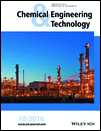Mass Transfer and Liquid-Film Formation in a Spray Tower for SO2 Removal in Sodium Hydroxide Solution
Abstract
Spray towers allow for controlling air pollution in which a liquid is sprayed in small droplets to produce a large interfacial area for mass transfer between a gas and a liquid phase. An experimental study of a spray tower for removing SO2 is described. The experiments were carried out under different operating conditions by varying the gas velocity, liquid flow rate, and SO2 concentration. SO2 removal efficiency, volumetric mass transfer coefficient, and liquid-film formation as a result of the collision of droplets against the tower wall are investigated. Removal efficiency and volumetric mass transfer coefficient are analyzed as a function of gas velocity, liquid flow rate, and SO2 concentration, while liquid-film formation is evaluated as a function of tower height. The results indicate high removal efficiency. Correlations to predict the volumetric mass transfer coefficient are also proposed.




